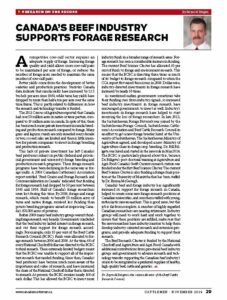Canada’s Beef Industry Supports Forage Research
This article written by Dr. Reynold Bergen, BCRC Science Director, originally appeared in the November 2014 issue of Canadian Cattlemen magazine and is reprinted on the BCRC Blog with permission of the publisher.

A competitive cow-calf sector requires an adequate supply of forage. Increasing forage quality and yield allows more cow-calf pairs to be maintained per acre of forage, or reduces the number of forage acres needed to maintain the same number of cow-calf pairs.
Better yields come from the development of better varieties and production practices. Statistics Canada data indicate that canola yields have increased by 13.5 bushels per acre since 1980, while tame hay yields have dropped by more than half a ton per acre over the same time frame. This is partly related to differences in how the research and technology transfer is funded.
The 2011 Census of Agriculture reported that Canada had over 50 million acres in native or tame pasture, compared to 19 million acres in canola. In spite of this, there has been much more private investment in canola breeding and production research compared to forage. Many grass and legume stands are only re-seeded every decade or two, so seed sales are limited and there is little incentive for private companies to invest in forage breeding and production research.
This lack of private investment has left Canada’s beef producers reliant on public (federal and provincial government and university) forage breeding and production research programs. These forage research programs have been declining in the same way as forage yields. A 2008 Canadian Cattlemen’s Association report entitled “Feed Grains and Forage Research and Commercialization in Canada” indicated that funding for forage research had dropped by 50% between 1985 and 1998. Half of Canada’s forage researchers were lost during this time. By 2008, forage and range research, which stands to benefit 50 million acres of tame and native forage, received less funding than potato breeding programs aimed at improving Canada’s 350,000 acres of potatoes.
Before 2009, many beef industry groups weren’t funding forage research very heavily. Governments concluded that the beef industry lacked interest in forage research, and cut their support for forage research accordingly. For example, only 10% of BCRC funds were allocated to forage research between 2006 and 2008. At the time, 6₵ of every National Check-off dollar was directed to the Beef Cattle Research Council to fund research. These extremely limited budgets meant that the BCRC was unable to support all of the important research that needed funding. Since then, Canada’s beef producers have become much more aware of the importance and value of research, and have increased the share of the National Check-off dollar that is directed to research. At present, the BCRC currently receives nearly 16₵ of each National Check-off dollar. This has allowed the BCRC to invest more industry funds in a broader range of research areas. Forage research has seen a considerable increase in funding. The current Beef Science Cluster has allocated 30% of funds to forage and environment research. This means that the BCRC is directing three times as much of its budget to forage research compared to when the CCA report first raised these issues in 2008. Dollar-wise, industry-directed investments in forage research have increased by nearly ten times.
As mentioned earlier, governments sometimes take their funding cues from industry signals, so increased beef industry investments in forage research have encouraged governments to invest as well. Industry’s investments in forage research have helped to start reversing the loss of forage researchers. In late 2012, the Saskatchewan Forage Network was joined by the Saskatchewan Forage Council, Saskatchewan Cattlemen’s Association and Beef Cattle Research Council in an effort to get a new forage breeder hired at the University of Saskatchewan. The Saskatchewan Ministry of Agriculture agreed, and developed a new “Ministry of Agriculture Chair in Forage Crop Breeding”. Dr. Bill Biligetu was hired, and started in the new role in May, 2014. The BCRC is particularly pleased about this, because Dr. Biligetu’s post-doctoral training at Agriculture and Agri-Food Canada’s Swift Current research station was funded under the first Beef Science Cluster. The current Beef Science Cluster is also funding a forage chair position at the University of Manitoba that has been staffed by Dr. Emma McGeough.
Canada’s beef and forage industry has significantly increased its support for forage research in Canada, has helped to create some new forage research positions at Canadian universities, and has seen them staffed with young, enthusiastic new researchers. This is good news, but this job is far from complete. A number of highly regarded Canadian researchers are nearing retirement. Industry groups will need to work hard and work together to ensure that these positions are re-filled, make sure that the new researchers have industry mentors to help them develop industry-oriented research and extension programs, and provide adequate funding to support their research.
Click here to subscribe to the BCRC Blog and receive email notifications when new content is posted.
The sharing or reprinting of BCRC Blog articles is typically welcome and encouraged, however this article requires permission of the original publisher.
We welcome your questions, comments and suggestions. Contact us directly or generate public discussion by posting your thoughts below.